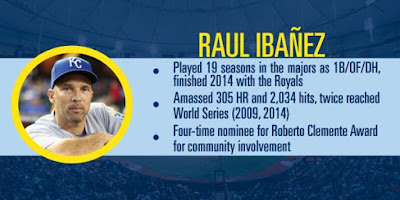Recently, we have seen the Rays put a lot of emphasis on building ties with the local community and fanbase. Many times over the past year, they have promoted their volunteer work, built playgrounds, pushed ticket package membership awards, and most recently, made sure they continue Joe Maddon's Thanksmas tradition.
Years ago, the Rays front office thought winning was the best way to build a fanbase. Of course, winning helps, but winning hearts and minds is equally important, if not moreso. Especially in an area with a sports demographic as diverse as Tampa Bay. The Rays have to provide incentive to be Rays fans. A bond with the community helps immensely.
There is reason to believe the Rays emphasis on community is also leaking into their managerial search.
Let's look at each of remaining candidates (pictures taken from the Rays twitter account):
Don Wakamatsu:
Kevin Cash:
Raul Ibanez:
We all know Don Wakamatsu has the most managerial experience of the three. He is the only one with any time as a manager. But Wakamatsu's profile is missing something. There is no mention of community. His profile only mentions baseball-related facts.
Of course, many might say that doesn't matter. What matters is what happens on the field. But besides guiding a winner, Joe Maddon was a big presence in the community. The Rays are probably looking for the same quality in their next manager. Someone to be a face of the franchise.
Which brings us to Cash and Ibanez.
As his profile says, Cash is not only a Tampa native, but a Tampa high school grad and a Florida State University alumnus. The profile doesn't mention Cash also represented Tampa in the Little League World Series in 1989, and according to a Tampa Bay Times article from 2005, his wife is from Gainesville and they owned a home in Tampa. Cash's local ties run deep. Marketing him to the local community would be easy.
While he would need time to learn how to manage and I don't expect him to be more mascot than manager, once he gets in the groove, expect to see Cash make many appearances in the area. He could kick off Little League Opening Day, appear at his old high school, and with thousands of FSU alumni in Tampa Bay, FSU Day/Night at Tropicana Field becomes a bigger event. As well, Cash could become a big part of the Tampa Baseball Museum, which is due to open in the next year.
(Disclaimer: I am one of the thousands of FSU alumni.)
Although he doesn't have Cash's direct Tampa roots, hiring Ibanez provides interesting, although different, marketing options. According to an MLB.com article from January, while in Seattle, Ibanez was involved with:
- The annual Mariners Care Cystic Fibrosis Golf Tournament
- The Page Ahead Children's Literacy Program, which works to make books available to at-risk children throughout the state of Washington
- Refuse to Abuse, the Mariners' partnership with the Washington State Coalition Against Domestic Violence
- The Make-A-Wish Foundation
- Boys & Girls Clubs
- Seattle Children's Hospital
- Treehouse
- Covenant House Pennsylvania
- Project H.O.M.E.
Additionally, while not Tampa specific, Ibanez grew up in Florida, and attended high school and college in Miami. Ibanez's parents are also from Cuba and Tampa's Cuban baseball influence runs deep. Marketing Ibanez to Tampa's Cuban community would be easy. A few months ago, I mentioned the Rays should do more to reach out to Tampa's Cuban community. Hiring Ibanez achieves that reach.
Strangely omitted from this discussion is that the Rays don't actually play in Tampa, nor anywhere near the Cuban part of Tampa Bay. They play in St. Petersburg and will continue to do so for the immediate future. But perhaps employing Cash or Ibanez and exploiting their bonds will help win some hearts and minds over the next few years. Then in a few years, maybe, just maybe, if the team gets a new stadium on the other side of the bay, and if either of the two are still employed by the Rays, the organization can fully exploit those bonds.

























